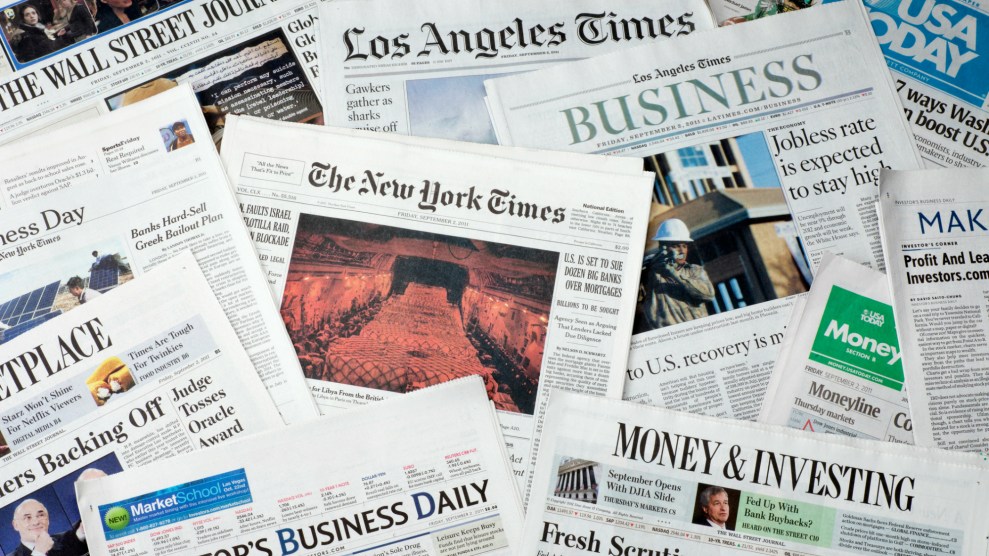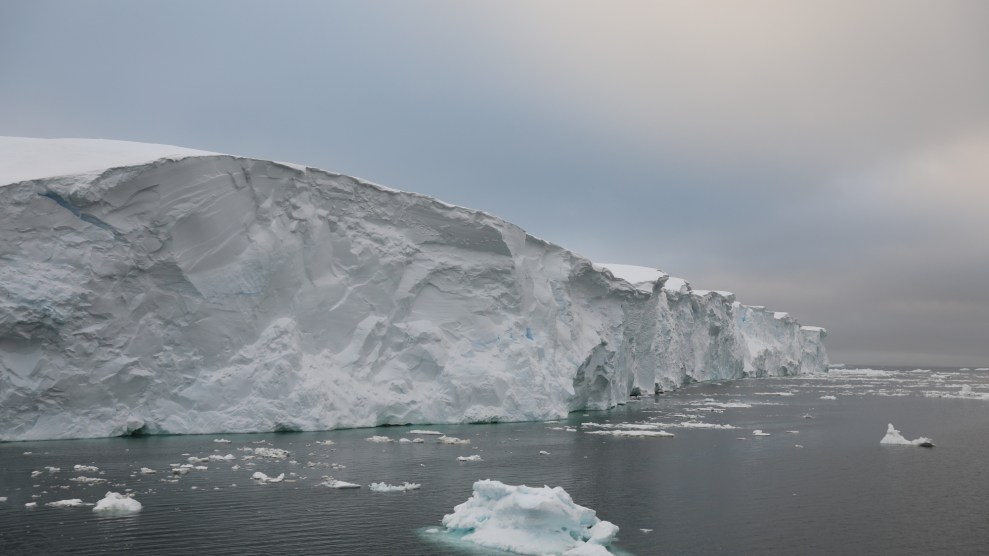
skodonnell, Getty Images
Last year, the New York Times called climate change “the most important story in the world.” So the Trump administration raised some eyebrows at a recent White House briefing when it turned to the newspaper of record for support in its effort to defend the president’s deeply unpopular decision to withdraw from the Paris climate agreement.
At the briefing, Environmental Protection Agency chief Scott Pruitt was asked whether Trump thinks humans are warming the planet. After refusing to comment on the president’s views, Pruitt said that the “degree of human contribution” to global warming remains uncertain. That uncertainty, Pruitt suggested, makes it difficult to decide how policymakers should respond.
And then he read aloud from the now-infamous Times column written in April by conservative never-Trumper Bret Stephens. The piece, which sparked a weeks-long media firestorm, made a convoluted case for more skepticism of climate change models—which Stephens equated to Hillary Clinton’s campaign polling. “Much…that passes as accepted fact is really a matter of probabilities,” he wrote. “That’s especially true of the sophisticated but fallible models and simulations by which scientists attempt to peer into the climate future.” Last week, NBC announced that it was hiring Stephens as a contributor.
Stephens, like Pruitt, insists he isn’t a climate change denier, but the columnist’s argument was nonetheless widely rejected by scientists; a few dozen of them signed an open letter arguing that Stephens “mischaracterizes both the certainties and uncertainties regarding climate change, and misrepresents how science reports uncertainties.”
It’s hardly surprising that a misleading New York Times column would be promoted by the administration of a president who sees global warming as a Chinese hoax. Skeptics have long sought to validate their views by injecting them into respectable media outlets. And they’ve frequently been successful. Here’s a short history of climate misinformation infiltrating the mainstream news media:
1990s and 2000s: Oil companies push climate denial in the news media
In 1997, countries around the world signed the the Kyoto Protocol, the world’s first serious attempt to curb greenhouse gas emissions. Months later, the New York Times reported on documents showing that the oil industry—including representatives from Exxon, Chevron, and Southern—were planning a campaign to “maximize the impact of scientific views consistent with ours on Congress, the media, and other key audiences.” The campaign, the Times reported, would include an effort to track “the percentage of news articles that raise questions about climate science and the number of radio talk show appearances by scientists questioning the prevailing views.” It would also develop a so-called “sound scientific alternative” to the UN’s Intergovernmental Panel on Climate Change (IPCC), an international body of scientists that evaluates climate change research.
Industry representatives told the Times that the plan was “tentative” and had not yet been approved. Nevertheless, the next decade-plus featured plenty of false-equivalency and he said/she said arguments in news stories about climate science. In many cases, the statements of scientists and other experts were “balanced” by those of deniers. In 2008, Maxwell Boykoff, who is now a University of Colorado professor, published a study in the journal Climatic Change that looked at news programs on ABC, CNN, NBC, and CBS from 1995 through 2004. He found that 70 percent of the networks’ global warming stories “perpetuated an informational bias” by including the unscientific views of climate skeptics. In another study published in 2004, Boykoff looked at coverage in major newspapers from 1988 through 2002 and found that half of the 636 randomly selected articles gave roughly the same attention to skeptics’ arguments about the supposedly natural causes of climate change as they did to the scientific consensus that humans are warming the planet.
The Washington Post, for example, published a 2004 story about a study that used climate modeling to demonstrate that climate change was leading to a greater risk of heat waves. The story quoted the Competitive Enterprise Institute’s Myron Ebell as saying, “Modeling is not science. This is a very small-potatoes paper based on modeling that can’t be proved or disproved” for the next 50 years. CEI is a conservative think tank that is closely associated with climate change denial and has also received funds from Koch-backed groups and other fossil fuel groups over the years. (Ebell would go on to lead the EPA transition team for the Trump administration.)
2006: CNN’s contrarian meteorologist
After a 2006 segment on global warming, CNN meteorologist Chad Myers appeared on air to deliver the day’s weather report. Anchor Miles O’Brien said to Myers: “You’re a little bit of a skeptic on global warming, I know.” Myers rejected that characterization and assured O’Brien that “CO2 is heating the atmosphere.” But he nonetheless went on to suggest that climate research may be exaggerated because of the heat island effect, in which heat retained by urban infrastructure causes cities to be artificially warmer. “Metro areas are getting warmer,” he said. “If you put the same thermometer out in the middle of a cornfield in Nebraska, maybe it wouldn’t be too much different. We’ll have to see. You know, I know this is happening; it’s just a matter of how much it is, that’s all.” (Actually, urban heat islands have a negligible effect on global temperatures, and Nebraska is indeed getting hotter).
Years later, Myers went on to publicly recant his climate contrarianism. He noted the theories he once thought were credible enough to broadcast are “now called ‘zombie theories,’ long since debunked myths about climate change that skeptics will continually bring up to counter the facts of man-made climate change.”
March 2007: NPR airs a debate on whether climate change is real
Intelligence Squared, an Oxford-style debate program that airs on NPR, hosted a debate on whether humans are the primary driver of global warming and how we should deal with it. On the side representing the overwhelming scientific consensus that humans are responsible for dangerous amounts of warming were two climate scientists and a NASA climate modeler. On the other side were two skeptical scientists: Richard Lindzen, an MIT professor who said the earth “is always warming or cooling,” and Philip Stott, a retired academic who made a similar point. Joining Lindzen and Stott was science fiction writer Michael Crichton, who claimed that scientists hadn’t shown “whether or not carbon dioxide is the contemporary driver for the warming we’re seeing.”
The introductory remarks by Robert Rosenkranz, chairman of Intelligence Squared, featured more false equivalence, including a jab at climate science: “Maybe a side that feels like there is nothing to debate might feel that there are perhaps some inconvenient truths on the other side that they would prefer not to deal with. I’m old enough to remember when there was a scientific consensus on global cooling, and this was in the 1970s with all kinds of alarmist data on that subject.”
February 2009: George Will vs. sea ice
George Will, whose Washington Post column appears in hundreds of papers and reaches millions of readers, is one of media’s most consistent voices of climate science denial. In 2009, he sparked a particularly intense backlash when he suggested that the case for manmade climate change was undermined by sea ice measurements. “As global levels of sea ice declined last year, many experts said this was evidence of man-made global warming,” he wrote. “Since September, however, the increase in sea ice has been the fastest change, either up or down, since 1979, when satellite record-keeping began. According to the University of Illinois’ Arctic Climate Research Center, global sea ice levels now equal those of 1979.”
But Will was wrong. The very source that he reportedly relied on for this argument—a statement issued by the University of Illinois researchers he cited—made clear that sea ice observations were, in fact, consistent with the scientific consensus surrounding global warming. Several Post journalists took the unusual step of criticizing their colleague’s column; one called out Will for providing readers “with misleading climate science information that conflicts with what scientists know.”
Fall 2009: Climategate
On November 17, 2009—just three weeks before the start of high-profile climate negotiations in Copenhagen—roughly 1,000 emails belonging to climate scientists were published on the internet. Based on a handful of out-of-context quotes, climate change deniers quickly declared that the apparently hacked emails revealed evidence of massive scientific fraud and labeled the episode “Climategate.” In particular, they seized on a 1999 email sent by British scientist Phil Jones, which famously referred to an effort to “hide the decline.” The context of the email made it clear that Jones was not referring to a deceptive effort to conceal a (non-existent) decline in global temperatures, but to a method for dealing with complications in tree-ring data.
As the controversy wore on, the Media Research Center—a conservative media watchdog organization—began demanding that the major broadcast networks cover the story. The networks complied. On December 4, NBC reported that “those who doubt that manmade greenhouse gases are changing the climate say these e-mails…show climate scientists massaging data” and aired footage of Patrick Michaels, a climate skeptic at the libertarian Cato Institute, calling for an investigation. On December 9, ABC reported—inaccurately—that “one of the most damning email exchanges credits [climate scientist Michael] Mann with a trick to hide the decline in temperatures.” Mann had done nothing of the sort. That same day, the Washington Post published an op-ed by Sarah Palin falsely claiming that the emails revealed that scientists had “manipulated data to ‘hide the decline’ in global temperatures.”
Months later, multiple investigations would conclude that the researchers had not committed scientific misconduct and that the science behind climate change remained as strong as ever.
2011: False balance across the pond
It’s not just US media. An independent body, the now-defunct BBC Trust, issued a July 2011 report on the BBC’s “over-rigid application of editorial guidelines on impartiality” that gave “undue attention to marginal opinion” on climate change. BBC Trust commissioned Steve Jones, an emeritus geneticist at University College London, who wrote in his independent review:
For at least three years, the climate change deniers have been marginal to the scientific debate but somehow they continued to find a place on the airwaves. Their ability so to do suggests that an over‐diligent search for due impartiality—or for a controversy—continue to hinder the objective reporting of a scientific story even when the internal statements of the BBC suggest that no controversy exists. There is a contrast between the clear demands for due impartiality in the BBC’s written guidelines and what sometimes emerges on air.
The BBC faced added pressure in 2014, when a House of Commons committee issued a report calling out the network for false equivalency.
2012: Avoiding controversy
In 2012, the Discovery Channel aired the documentary titled Frozen Planet, co-produced by BBC, which discussed how life and nature were changing in the warming Arctic and Antarctic. The program made scant mention of the human causes of that warming. The series producer said at the time the the filmmakers didn’t want to emphasize the science on climate change because it “would have undermined the strength of an objective documentary, and would then have become utilized by people with political agendas,” according to the New York Times. Climate activists targeted the channel with a campaign asking for more of a focus on climate change.
2013: The pause
In recent years, a favorite argument of climate change deniers has been that global warming stopped or slowed dramatically after the 1990s, which, they claim, calls into question the scientific consensus that humans are dangerously warming the planet. It’s a deeply misleading argument that relies on the fact that 1998 was an unusually hot year and ignores the reality that 16 of the 17 warmest years on record have occurred since 2001. But in the fall of 2013, just as the IPCC was rolling out a landmark report on global warming, the mainstream media took the bait. A Media Matters study found that news outlets mentioned the so-called “pause” in 41 percent of their stories about the IPCC. Former Mother Jones reporter Chris Mooney highlighted one particularly problematic CBS News report from the time:
At the outset of the segment, CBS’s Mark Phillips intoned: “Another inconvenient truth has emerged on the way to the apocalypse. The new UN report on climate change is expected to blame man-made greenhouse gases more than ever for global warming. But there’s a problem. The global atmosphere hasn’t been warming lately.”
Then followed an animation, seeming to show that since the year 1998, rising carbon dioxide levels in the atmosphere haven’t been matched by rising temperatures. Soon, CBS cut to a scientist trying to explain this apparent global warming “pause” by saying that the missing heat has gone into the oceans. Then, presumably for balance, came an interview with a climate skeptic who, when asked whether the “pause” blunts the urgency of doing something about global warming, replied that “It has already.”
This pause, it turns out, likely never existed. The National Oceanic and Atmospheric Administration published a paper in 2015 that readjusted its dataset to account for a “cooling bias” in how scientists measured global temperatures. The results suggested that atmospheric warming hadn’t actually slowed down, let alone stopped.
2013: False balance on the opinion pages
USA Today pairs its editorials on “controversial” topics with pieces expressing opposing views. In October 2013, this convention led to the widely read paper running an editorial on climate change alongside a fact-challenged op-ed by Joseph Bast, president of the Heartland Institute, which has received funding from fossil fuel companies. In this op-ed, Bast falsely claimed that no warming had occurred in 15 years and that it was now time to listen to “other voices in the debate” rather than the IPCC.
2017: Bret Stephens
In late April, the New York Times hired Bret Stephens, a former Wall Street Journal columnist with a history of characterizing climate change as an “imaginary enemy” and claiming that temperatures would be “about the same” in a century. When Stephens’ debut Times column cast doubt on climate models that predict significant future warming, the backlash was immediate. “No subject since the election has come close to producing this kind of anger toward The Times,” wrote Liz Spayd, the paper’s public editor at the time. Days later, NBC hopped on the bandwagon, hiring frequent climate misinformer (see above) George Will as a contributor. Last week, the network squared the circle when it hired Stephens, too. His views contradict NBC’s own reporting that the world’s top scientists agree that “unless the world changes course quickly and dramatically, the fundamental systems that support human civilization are at risk.”
* This story has been revised for clarity.













